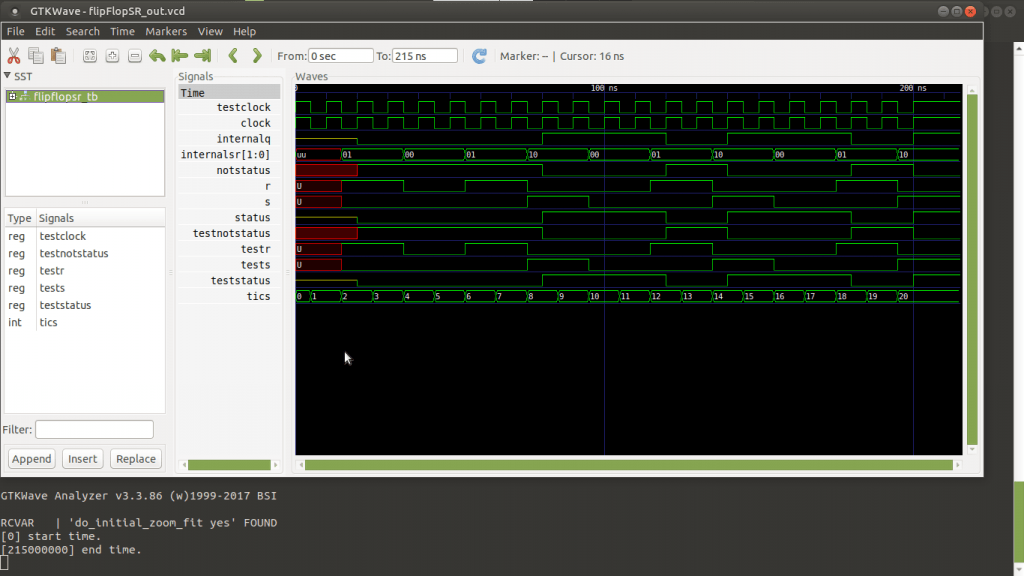
Aquí vengo de nuevo con más code-katas, ahora con un flip flop SR. Un flip flop es un biestable, un circuito multivibrador que permanece en dos estados, mientras las señales de entrada no cambian. Se suelen usar mucho en electrónica para almacenar bits.
El flip flop SR es un biestable que con sus dos entradas se pone a 0 o a 1. Con la entrada R se pone a cero, y con la S a 1. Simple y llanamente este es el funcionamiento. Si recibe tanto R como S a cero, entonces permanece en el estado que tenga. Y si recibe R y S a 1, está prohibido, con lo que entra en un estado inestable.
Más información sobre los biestables aquí:
https://es.wikipedia.org/wiki/Biestable
El código fuente del flip flop SR
library IEEE;
use IEEE.std_logic_1164.all;
entity flipFlopSR is
port (
status, notStatus : out std_logic;
clock, s, r : in std_logic
);
end entity;
architecture arch_flipFlopSR of flipFlopSR is
signal internalQ : std_logic;
signal internalSR : std_logic_vector (1 downto 0);
begin
status <= internalQ;
notStatus <= not internalQ;
main_process : process (clock)
begin
internalSR <= s & r;
if rising_edge (clock) then
report "Procesando tic tac.. clock=" & std_logic'image(clock);
report " s=" & std_logic'image(s);
report " r=" & std_logic'image(r);
if internalSR = "00" then
--internalQ <= internalQ;
elsif internalSR = "01" then
internalQ <= '0';
elsif internalSR = "10" then
internalQ <= '1';
else -- internalSR is "11"
-- Esto no está permitido, queda en estado inestable.
internalQ <= 'Z';
end if;
end if;
end process;
end architecture;El código fuente del banco de pruebas del flip flop SR
library IEEE;
use IEEE.std_logic_1164.all;
entity flipFlopSR_tb is
end entity;
architecture arch_flipFlopSR_tb of flipFlopSR_tb is
component flipFlopSR is
port (
status, notStatus : out std_logic;
clock, s, r : in std_logic
);
end component;
signal testStatus, testNotStatus, testS, testR : std_logic;
signal testClock : std_logic := '0';
signal tics : integer := 0;
begin
testing_unit: flipFlopSR port map (
status => testStatus,
notStatus => testNotStatus,
clock => testClock,
s => testS,
r => testR
);
generate_100Mhzs_clock : process
begin
report "Tic tac.. testClock=" & std_logic'image(testClock);
testClock <= not testClock;
if testClock = '1' then tics <= tics + 1; end if;
if tics >= 20 then wait; end if;
wait for 5 ns; -- Tiempo de espera en un flanco de reloj.
end process;
main_process : process
begin
wait for 15 ns;
-- Reset inicial
testS <= '0'; testR <= '1'; wait for 20 ns;
testS <= '0'; testR <= '0'; wait for 20 ns;
testS <= '0'; testR <= '1'; wait for 20 ns;
testS <= '1'; testR <= '0'; wait for 20 ns;
--testS <= '1'; testR <= '1'; wait for 20 ns;
testS <= '0'; testR <= '0'; wait for 20 ns;
testS <= '0'; testR <= '1'; wait for 20 ns;
testS <= '1'; testR <= '0'; wait for 20 ns;
--testS <= '1'; testR <= '1'; wait for 20 ns;
testS <= '0'; testR <= '0'; wait for 20 ns;
testS <= '0'; testR <= '1'; wait for 20 ns;
testS <= '1'; testR <= '0'; wait for 20 ns;
--testS <= '1'; testR <= '1'; wait for 20 ns;
wait;
end process;
end architecture;




